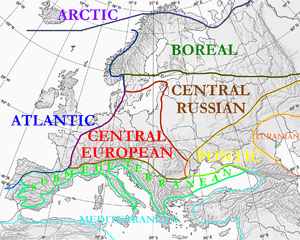Flora facts for kids
In botany, flora (plural: floras or florae) has two meanings.
The first meaning refers to all plant life in an area or time period (especially the naturally occurring or indigenous plant life).
The second meaning refers to a book or other work which describes the plant species in an area or time period, with the aim of allowing identification.
The term flora comes from Latin language Flora, the goddess of flowers in Roman mythology. The corresponding term for animal life is fauna.
Plants are grouped into floras based on region, period, special environment, or climate. Regions can be geographically distinct habitats like mountain vs. flatland. Floras can mean plant life of an historic era as in fossil flora.
Bacterial organisms are sometimes included in a flora. Other times, the terms bacterial flora and plant flora are used separately.
Flora classifications
Plants are grouped into floras based on region (floristic regions), period, special environment, or climate. Regions can be distinct habitats like mountain vs. flatland. Floras can mean plant life of a historic era as in fossil flora. Lastly, floras may be subdivided by special environments:
- Native flora. The native and indigenous flora of an area.
- Agricultural and horticultural flora (garden flora). The plants that are deliberately grown by humans.
- Weed flora. Traditionally this classification was applied to plants regarded as undesirable, and studied in efforts to control or eradicate them. Today the designation is less often used as a classification of plant life, since it includes three different types of plants: weedy species, invasive species (that may or may not be weedy), and native and introduced non-weedy species that are agriculturally undesirable. Many native plants previously considered weeds have been shown to be beneficial or even necessary to various ecosystems.
Documentation of floras
The flora of a particular area or time period can be documented in a publication also known as a "flora" (often capitalized as "Flora" to distinguish the two meanings when they might be confused). Floras may require specialist botanical knowledge to use with any effectiveness. Traditionally they are books, but some are now published on CD-ROM or websites.
It is said that the Flora Sinensis by the Polish Jesuit Michał Boym was the first book that used the name "Flora" in this meaning, a book covering the plant world of a region. However, despite its title it covered not only plants, but also some animals of the region.
A published flora often contains diagnostic keys. Often these are dichotomous keys, which require the user to repeatedly examine a plant, and decide which one of two alternatives given best applies to the plant.
Other pages
- Biome — a major regional group of distinctive plant and animal communities.
- Vegetation — a general term for the plant life of a region.
- Fauna
See also
 In Spanish: Flora para niños
In Spanish: Flora para niños




